Eaton Transmission FS-5106A, FS6206A Service Manual

Service Manual
Fuller Mid-Range Transmissions
TRSM0160
October 2007
FS-5106A
FS-6206A
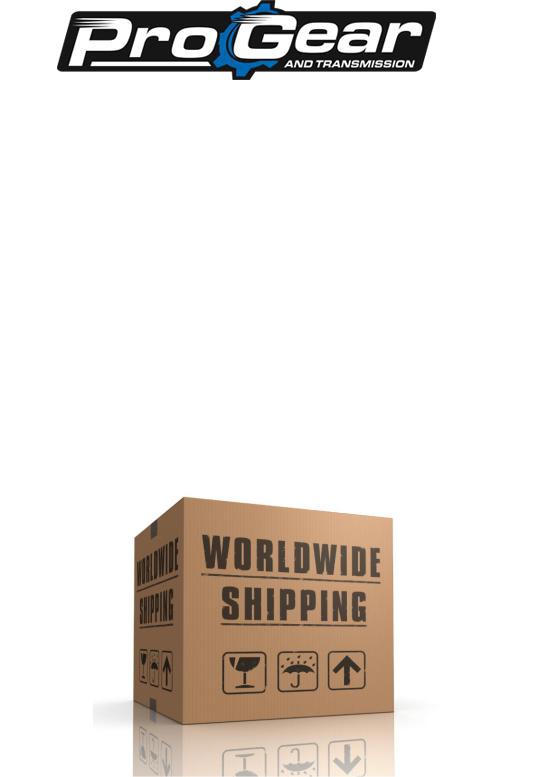
For parts or service call us Pro Gear & Transmission, Inc.
1(877) 776-4600
(407)872-1901 parts@eprogear.com
906 W. Gore St. Orlando, FL 32805

Before starting a vehicle always be seated in the drivers seat, place the transmission in neutral, set the parking brakes and disengage the clutch.
Before working on a vehicle place the transmission in neutral, set the parking brakes and block the wheels.
Before towing the vehicle place the transmission in neutral, and lift the rear wheels off the ground or disconnect the driveline to avoid damage to the transmission during towing.
c U T 8 0 0 7 k 1 / 8 8
©1989 Eaton Corporation. All rights reserved.

TABLE OF CONTENTS
FOREWORD
MODEL DESIGNATIONS AND SPECIFICATIONS
LUBRICATION
OPERATION
POWER FLOW
TORQUE RECOMMENDATIONS
PREVENTIVE MAINTENANCE
P R E C A U T I O N S
DISASSEMBLY
INSPECTION
REASSEMBLY
DISASSEMBLY AND REASSEMBLY–SHIFTING CONTROLS
GEARSHIFT LEVER HOUSING ASSEMBLY
SHIFT BAR HOUSING ASSEMBLY
REMOVAL–YOKE AN D CLUTCH HOUSING
DISASSEMBLY–TRANSMISSION
REASSEMBLY–TRANSMISSION
INSTALLATION–CLUTCH HOUSING AN D YOKE
INSTALLATION–SHIFTING CONTROLS
SHIFT BAR HOUSING ASSEMBLY
GEARSHIFT LEVER HOUSING ASSEMBLY

FOREWORD
This manual is designed to provide detailed information necessary to service and repair the Fuller@ Transmission listed on the cover.
As outlined in the Table of Contents, the manual is divided into 3 main sections:
a.Technical information and reference
b.Removal, disassembly, reassembly and installation
c.Options
The format of the manual is designed to be followed in its entirety if complete disassembly and reassembly of the transmission is necessary. But if only one component of the transmission needs to be repaired, refer to the Table of Contents for the page numbers showing that component. For example, if you need to work on the Shift Bar Housing, you will find instructions for removal, disassembly and reassembly on page 18. Instructions for installation are on page 53. Service Manuals, Illustrated Parts Lists, Drivers Instructions, and other forms of product
service information for these and other Fuller Transmissions are available upon request. A Technical Literature Order Form may be found in the back of this manual. You may also obtain Service Bulletins, detailing information on product improvements, repair procedures and other service-related subjects by writing to the following address:
EATON CORPORATION TRANSMISSION DIVISION Technical Service Department PO. Box 4013
Kalamazoo, Michigan 49003 (61 6) 342-3344
Every effort has been made to ensure the accuracy of all information in this brochure. However, Eaton Transmission Division makes no expressed or implied warranty or representation based on the enclosed information. Any errors or omissions may be reported to Training and Publications, Eaton Transmission Division, PO, Box 4013, Kalamazoo, Ml 49003,
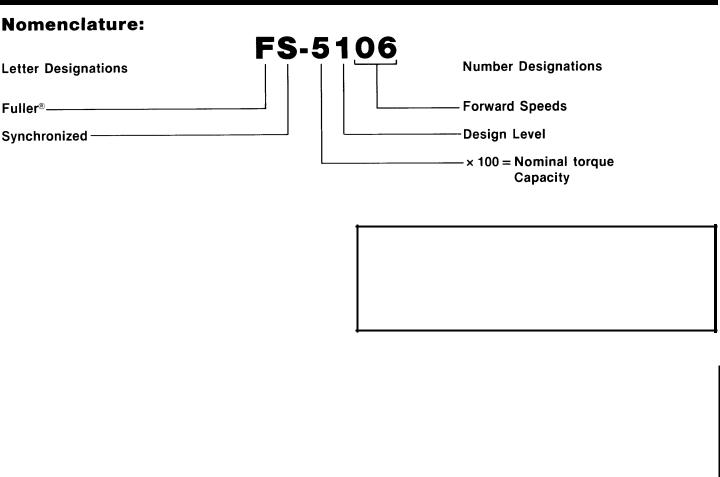
MODEL DESIGNATIONS
AND SPECIFICATIONS
IMPORTANT: All Fuller Transmissions are identified by model and serial number. This information is stamped on the transmission identification tag and affixed to the case.
DO NOT REMOVE OR DESTROY THE TRANSMISSION IDENTIFICATION TAG.
Specifications:
|
|
|
|
|
|
|
|
|
|
|
|
|
|
|
|
|
|
|
|
|
/ |
|
|
|
|
|
|
|
|
|
|
Gear Ratios |
|
|
|
|
|
|
Relative Speed |
Note 1 |
Note 2 |
Note 3 |
|||
|
|
|
|
|
|
|
|
|
|
|
|
|
|
|
PTO Gear to |
Length |
Weight |
011 Capacity |
||||
|
|
No |
|
|
|
|
|
|
|
|
|
|
|
|
|
|
Input R.P.M. |
In. |
Lbs. |
Pints |
||
|
|
|
|
|
|
|
|
|
|
|
|
|
|
|
|
|
|
(mm) |
(Kg ) |
(Liters) |
||
|
Model |
Speeds |
|
1st |
|
2nd |
3rd |
|
4th |
|
5th |
|
6th |
|
Reverse |
|
Left |
Right |
||||
|
|
|
|
|
|
|
|
|
|
|
|
|||||||||||
|
FS-5106 |
6 |
|
9.01 |
|
5.271 |
3.250 |
|
2.040 |
|
1.362 |
|
1.000 |
|
8.625 |
|
.522 |
522 |
25.56 |
358 |
|
|
|
|
|
|
|
|
|
|
(649) |
(162) |
(8.52) |
|
|||||||||||
|
|
|
|
|
|
|
|
|
|
|
|
|
|
|
|
|
|
|
|
|||
|
|
|
|
|
|
|
|
|
|
|
|
|
|
|
|
|
|
|
|
|
|
|
|
FS-6206 |
6 |
|
9.01 |
|
5.271 |
3.250 |
|
2.040 |
|
1.362 |
|
1.000 |
|
8.625 |
|
.522 |
522 |
25.56 |
358 |
|
|
|
|
|
|
|
|
|
|
(649) |
(162) |
(8.52) |
|
|||||||||||
|
|
|
|
|
|
|
|
|
|
|
|
|
|
|
|
|
|
|
|
|||
|
|
|
|
|
|
|
|
|
|
|
|
|
|
|
|
|
|
|
|
|
|
|
|
See Chart Notes. |
|
|
|
|
|
|
|
|
|
|
|
|
|
|
|
|
|
|
|
||
CHART NOTES: |
|
|
|
|
|
|
|
|
|
|
|
|
|
|
|
|
|
|
|
|||
1. Lengths measured from face of clutch |
housing |
to |
center line |
of yoke. |
|
|
|
|
|
|
||||||||||||
2. Weights |
include |
shift |
bar housing and |
end yoke, |
less clutch |
housing, |
tower |
assembly and |
clutch |
release |
||||||||||||
parts. For more information on available clutch housings, refer to publication FUL-140 - “Clutch Housing Chart.” All weights are approximate.
3. Oil capacities are approximate, |
depending on inclination |
of engine and transmission. Always fill transmis- |
sion with proper grade and type |
of lubricant to level of |
filler opening. See LUBRICATION. |

LUBRICATION
Proper Lubrication . . .
the Key to long transmission life
Proper lubrication procedures are the key to a good allaround maintenance program. If the oil is not doing its job, or if the oil level is ignored, all the maintenance procedures in the world are not going to keep the transmission running or assure long transmission life.
Eaton® Fuller® Transmissions are designed so that the internal parts operate in a bath of oil circulated by the motion of gears and shafts.
Thus, all parts will be amply lubricated if these procedures are closely followed:
1.Maintain oil level. Inspect regularly.
2.Change oil regularly.
3.Use the correct grade and type of oil.
4.Buy from a reputable dealer.
|
|
|
|
Lubrication Change |
and Inspection |
|
|
|
|||||||
|
I |
Eaton® Roadranger® CD50 Transmission Fluid |
|
|
|||||||||||
|
|
|
|
|
|
||||||||||
|
|
|
HIGHWAY USE — Heavy Duty and MidRange |
|
|
||||||||||
|
|
|
|
|
|
|
|
|
|
|
|
||||
|
|
|
First 3,000 to 5,000 miles |
|
|
|
|
|
Factory fill |
|
|
||||
|
|
|
(4827 to 8045 Km) |
|
|
|
|
Initial |
drain, |
|
|
||||
|
|
|
|
|
|
|
|
|
|
|
|
||||
|
I |
Every 10,000 miles |
|
|
|
Check |
fluid |
level. |
|
|
|||||
|
(16090 Km) |
|
|
|
|
Check for leaks. |
I |
||||||||
|
|
|
|
|
|
|
|
||||||||
|
|
|
|
Heavy Duty Highway Change Interval |
|
|
|
||||||||
|
|
|
|
|
|
|
|
|
|
||||||
|
|
|
Every 250,000 miles |
|
|
Change |
transmission |
|
|
||||||
|
|
|
(402336 Km) |
|
|
|
|
|
|
|
fluid. |
|
|
||
|
|
|
|
|
|
|
|
|
|||||||
|
|
|
|
|
Mid-Range Highway Change Interval |
|
|
|
|||||||
|
|
|
|
|
|
|
|
|
|||||||
|
|
|
Every 100,000 miles (160,000 Km) |
|
Change |
transmission |
|
|
|||||||
|
|
|
or every 3 years |
whichever occurs |
first. |
|
|
|
|
fluld. |
|
|
|||
|
|
|
|
|
|
|
|
|
|
|
|
|
|||
I |
|
|
|
|
O F F - H I G H W A Y U S E |
|
|
|
|
|
|
||||
|
|
|
First |
30 |
hours |
|
|
|
Factory fill |
initial |
drain, |
|
|
||
|
|
|
|
|
|
I |
|||||||||
|
|
|
|
|
|
|
|
|
|
|
|
|
|||
|
|
|
Every |
40 |
hours |
|
Inspect |
fluid |
level. Check for |
leaks. |
I |
||||
|
|
|
Every 500 hours |
|
Change transmission |
fluld |
where |
|
|
||||||
|
|
|
|
|
|
|
severe dirt |
conditions |
exist. |
|
|
||||
|
|
|
|
|
|
|
|
|
|||||||
|
|
|
Every 1,000 hours |
|
|
Change transmission fluld |
|
|
|||||||
|
|
|
|
|
|
|
|
(Normal off-highway use). |
|
|
|||||
|
|
|
|
|
|
|
|
|
|
||||||
|
|
|
|
|
Heavy Duty Engine Lubricant or |
|
|
|
|
||||||
|
|
|
|
|
|
|
|
|
|||||||
|
|
|
|
|
Mineral Gear Lubricant |
|
|
|
|
|
|||||
|
|
|
|
|
|
|
|
|
|
|
|
|
|||
|
|
|
|
|
|
H I G H W A Y U S E |
|
|
|
|
|
|
|||
|
|
|
|
|
|
|
|
|
|
|
|
||||
|
|
|
First 3,000 to 5,000 miles |
|
|
|
|
|
Factory fill |
|
|
||||
|
|
|
(4827 to 8045 Km) |
|
|
|
|
initial |
drain. |
|
|
||||
|
|
|
|
|
|
|
|
|
|
||||||
I |
Every 10,000 miles |
|
|
Inspect lubricant |
level. |
I |
|||||||||
(16090 Km) |
|
|
|
|
Check for leaks. |
||||||||||
|
|
|
Every 50,000 miles |
|
|
Change |
transmission |
|
|
||||||
|
|
|
(80450 Km) |
|
|
|
|
|
|
lubricant. |
|
|
|||
|
|
|
|
|
|
|
|
|
|
|
|
|
|||
|
|
|
|
|
|
OFF-HIGHWAY USE |
|
|
|
|
|
|
|||
|
|
|
|
|
|
|
|
|
|
|
|
|
|||
|
|
|
First |
30 |
hours |
Change |
transmission |
lubricant on |
new |
units. |
I |
|
|||
|
|
|
Every |
40 |
hours |
Inspect lubricant |
level. Check |
for |
leaks. |
I |
|||||
|
|
|
Every 500 hours |
|
Change transmission |
lubricant where |
|
|
|||||||
|
|
|
|
|
|
|
severe dirt |
conditions |
exist. |
|
|
||||
|
|
|
|
|
|
|
|
||||||||
|
|
|
Every 1,000 hours |
|
Change transmission lubricant |
|
|
||||||||
|
|
|
|
|
|
|
|
(Normal |
off-highway |
use). |
|
|
|||
|
|
|
|
|
|
|
|
|
|
|
|
|
|
|
|
Recommended |
Lubricants |
|
|
|
Fahrenheit |
|
Grade |
(Celsius) |
|
Ambient |
|
Type |
(SAE) |
Temperature |
|
|
|
Eaton® Roadranger® |
|
|
CD50 Transmission |
|
|
F l u i d |
50 |
All |
|
|
|
Heavy Duty Engine 011 |
|
|
MIL-L-2104B, C or D or |
5 0 |
Above 10°F(-12°C.) |
API-SF or API-CD |
4 0 |
Above 10°F(-12°C.) |
(Previous API deslgnations |
30 |
Below 10°F(-12°C) |
acceptable) |
|
|
|
|
|
Mineral Gear Oil with rust 90 |
Above 10°F(-12°C) |
|
and oxidation Inhibitor |
80W |
Below 10 °F(-12°C) |
API-GL-1 |
|
|
|
|
|
The use of mild EP gear oil or multi-purpose gear oil is not recommended, but if these gear oils are used, be sure to adhere to the following limitations:
Do not use mild EP gear oil or multi-purpose gear oil when operating temperatures are above 230°F (110°C). Many of these gear oils, particularly 85W140, break down above 230°F and coat seals, bearings and gears with deposits that may cause premature failures. If these deposits are observed (especially a coating on seal areas causing oil leakage), change to Eaton Roadranger CD50 transmission fluid, heavy duty engine oil or mineral gear oil to assure maximum component life and to maintain your warranty with Eaton. (Also see “Operating Temperatures”.)
Additives and friction modifiers are not recommended for use in Eaton Fuller transmissions.
Proper Oil Level
Make sure oil is level with filler opening. Because you can reach oil with your finger does not mean oil is at proper level. One inch of oil level is about one gallon
of oil.
Draining Oil
Drain transmission while oil is warm. To drain oil remove the drain plug at bottom of case. Clean the drain plug before re-installing.
Refilling
Clean case around filler plug and remove plug from side of case. Fill transmission to the level of the filler opening. If transmission has two filler openings, fill to level of both openings.
The exact amount of oil will depend on the transmission inclination and model. Do not over fill—this will cause oil to be forced out of the transmission.
When adding oil, types and brands of oil should not be mixed because of possible incompatibility.
Change the oil filter when fluid or lubricant is changed.
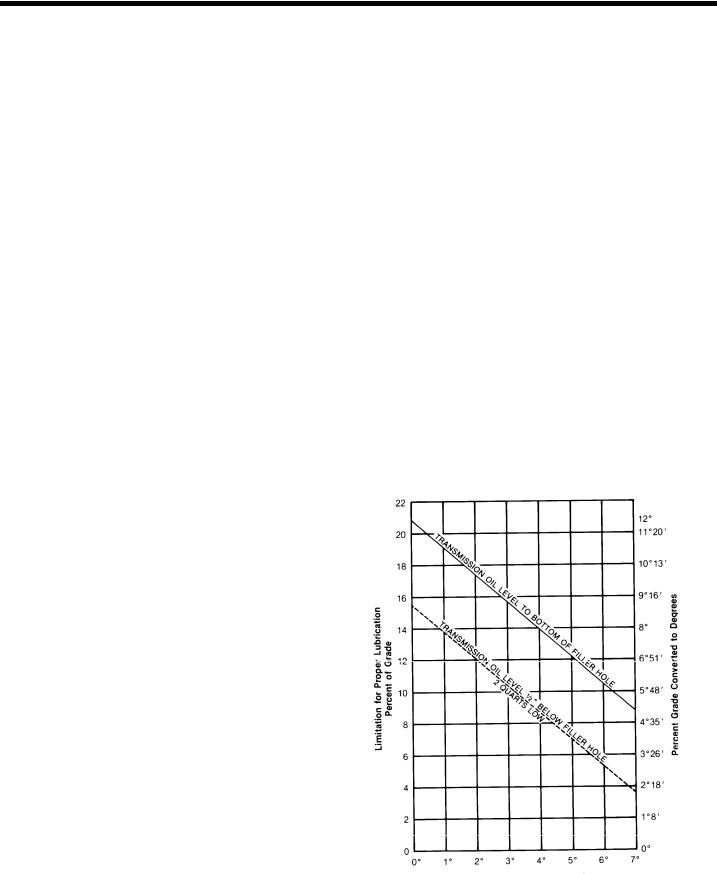
LUBRICATION
Operating Temperatures
—With Eaton® Roadranger®
CD50 Transmission Fluid
Heavy Duty Engine Oil
and Mineral Oil
The transmission should not be operated consistently at temperatures above 250°F (120°C). However, intermittent operating temperatures to 300°F (149°C) will not harm the transmission. Operating temperatures above 250°F increase the lubricant’s rate of oxidation and shorten its effective life. When the average operating temperature is above 250°F, the transmission may require more frequent oil changes or external cooling.
The following conditions in any combination can cause operating temperatures of over 250°F: (1) operating consistently at slow speeds, (2) high ambient temperatures, (3) restricted air flow around transmission, (4) exhaust system too close to transmission, (5) high horsepower, overdrive operation.
External oil coolers are available to reduce operating temperatures when the above conditions are encountered.
Transmission Oil Coolers are:
Recommended
—With engines of 350 H.P. and above with overdrive transmissions
Required
—With engines 399 H.P. and above with overdrive transmissions and GCW’S over 90,000 lbs.
—With engines 399 H.P. and above and 1400 Lbs.-Ft. or greater torque
—With engines 450 H.P. and above
— With EP or Multipurpose Gear Oil
Mild EP gear oil and multipurpose gear oil are not recommended when lubricant operating temperatures are above 230°F (110°C). In addition, transmission oil coolers are not recommended with these gear oils since the oil cooler materials may be attacked by these gear oils. The lower temperature limit and oil cooler restriction with these gear oils generally limit their success to milder applications.
Proper Lubrication Levels as Related to Transmission Installation Angles
If the transmission operating angle is more than 12 degrees, improper lubrication can occur. The operating angle is the transmission mounting angle in the chassis plus the percent of upgrade (expressed in degrees).
The chart below illustrates the safe percent of upgrade on which the transmission can be used with various chassis mounting angles.
For example: if you have a 4 degree transmission mounting angle, then 8 degrees (or 14 percent of grade) is equal to the limit of 12 degrees. If you have a O degree mounting angle, the transmission can be operated on a 12 degree (21 percent) grade.
Anytime the transmission operating angle of 12 degrees is exceeded for an extended
period of time the transmission should be equipped with an oil pump or cooler kit to insure proper lubrication.
Note on the chart the effect low oil levels can have on safe operating angles. Allowing the oil level to fall 1/2" below the filler plug hole reduces the degree of grade by approximately 3 degrees (5.5 percent).
Proper Lubrication Levels are Essential!
Transmission Mounting Angle
Dotted line showing “2 Quarts Low” is for reference only. Not recommended.
5
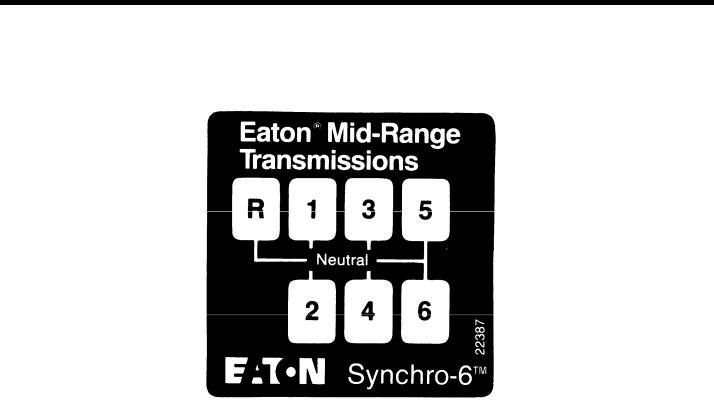
OPERATION
Gear Shift Lever Pattern and
Shifting Instructions
Follow the simple 6-speed shift pattern . . .
General Information
These transmissions have six forward speeds and one reverse, and are shifted as you would shift any synchronized manual transmission, following the simple 6-speed shift pattern.
Driving Tips
Ž Always use the clutch when making upshifts or downshifts. Premature synchronizer failure can result from not using the clutch.
●Always select a starting gear that will provide sufficient reduction for the load and terrain.
●Never downshift at too high of a road speed.
●Never slam or jerk the shift lever to complete gear engagement.
●Never coast with the transmission in neutral and the clutch dis-engaged.
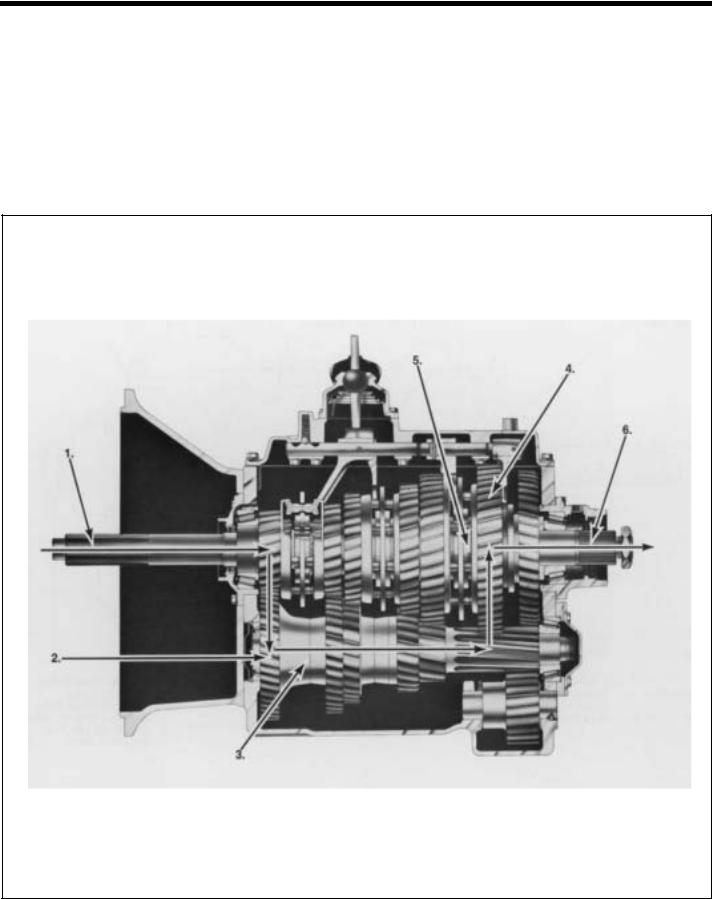
POWER FLOW
The transmission must efficiently transfer the engine's power, in terms of torque, to the vehicle's rear wheels. Knowledge of what takes place in the transmission during torque transfer is essential when trouble-shooting and making repairs becomes necessary.
1. |
Power (torque) from the engine is transferred to the input shaft and drive gear. |
|||
2. |
Torque is transferred to countershaft drive gear. |
|||
3. |
Torque |
is |
delivered along countershaft to all |
countershaft gears. |
4. |
Torque |
is |
transferred to "engaged" mainshaft |
gear. The cross section illustrates 1st speed gear position. |
5.Internal clutching teeth of engaged mainshaft gear transfers torque to mainshaft through synchronizer assembly.
6.Mainshaft transfers torque directly to driveshaft through rear yoke.
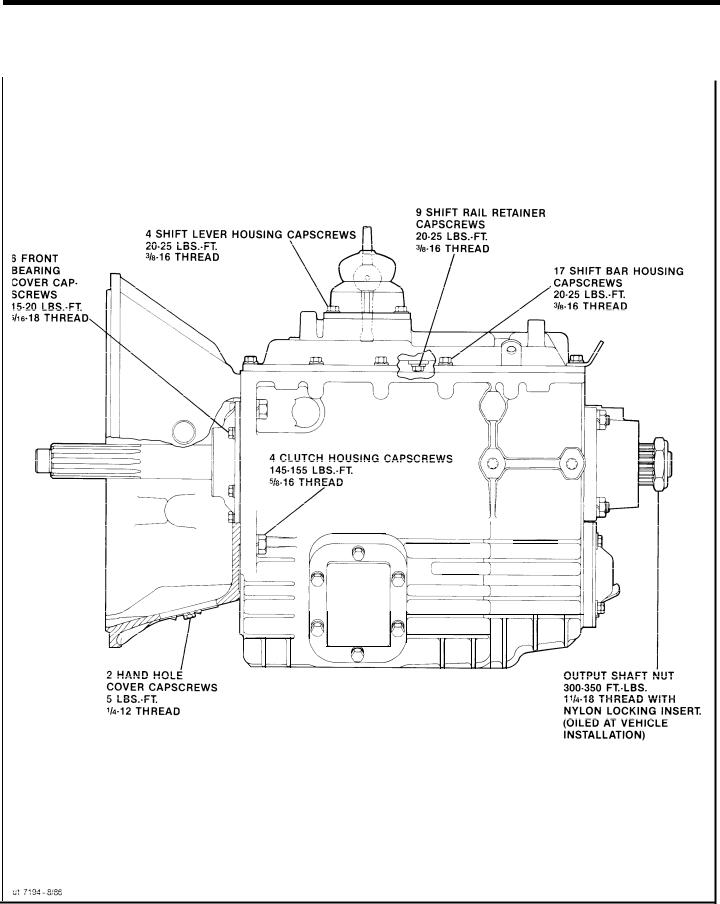
TORQUE RECOMMENDATIONS
Correct torque application is important to assure long transmission life, |
Over or under tightening of fasteners |
||
can result in a loose |
installation and, in many instances, can |
eventually cause damage to the transmission. Use |
|
a torque wrench to |
obtain recommended torque ratings. Do |
not torque |
capscrews dry. |
|
|
|
|
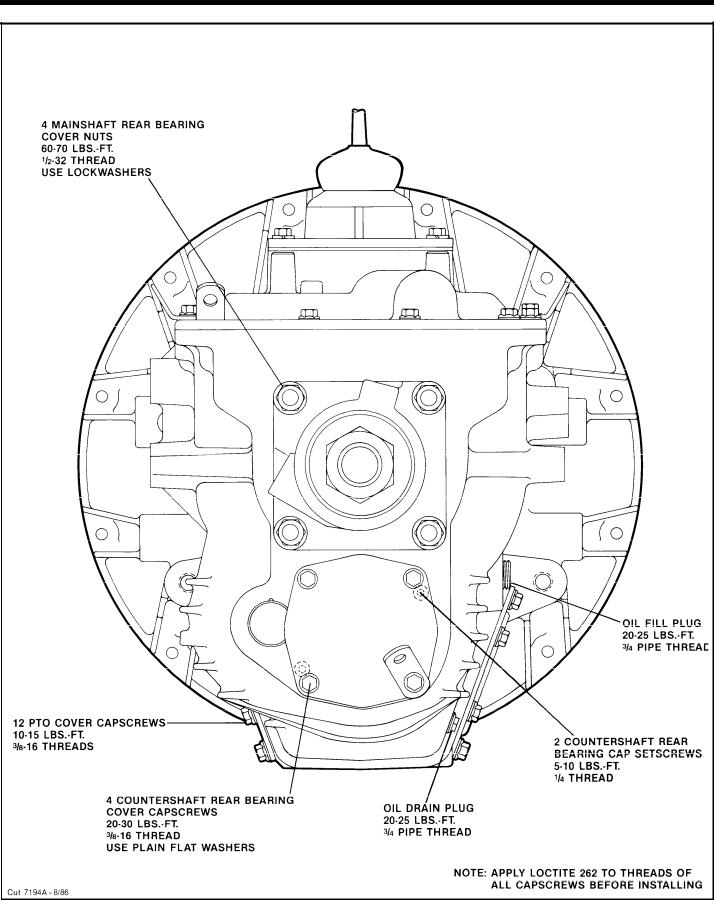
TORQUE RECOMMENDATIONS
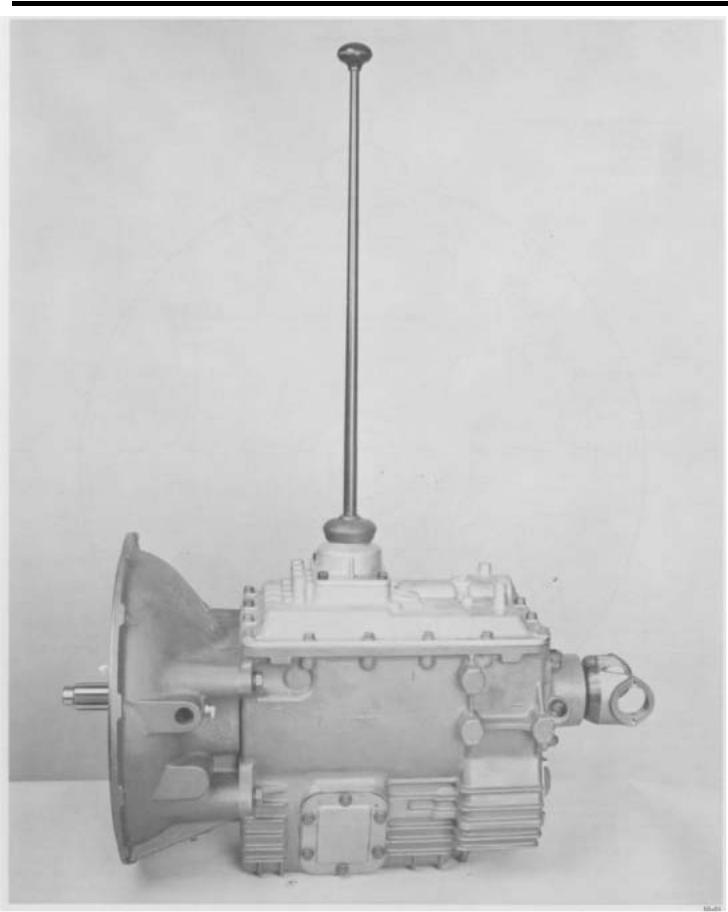
PREVENTIVE MAINTENANCE

PREVENTIVE MAINTENANCE
PREVENTIVE MAINTENANCE CHECK CHART
CHECKS WITHOUT PARTIAL DISASSEMBLY OF CHASSIS OR CAB
1.Clutch Housing Mounting
a.Check all capscrews of clutch housing flange for looseness.
2.Clutch Release Bearing (Not Shown)
a.Remove hand hole cover and check radial and axial clearance in release bearing.
b.Check relative position of thrust surface of release bearing with thrust sleeve on pushtype clutches.
3.Clutch Pedal Shaft and Bores
a.Pry upward on shafts to check wear.
b.If excessive movement is found, remove clutch release mechanism and check bushings in bores and wear on shafts.
4.L u b r i c a n t
a.Change at specified service intervals.
b.Use only the types and grades as recommended. See LUBRICATION.
5.Filler and Drain Plugs
a.Remove filler plug and check level of lubricant at specified intervals. Tighten filler and drain plugs securely.
8.Gear Shift Lever Housing Assembly
a.Remove the gear shift lever housing assembly from transmission.
b.Check tension spring and washer for set and wear.
c.Check bottom end of gear shift lever for wear of slots. Also check for wear of finger assembly.
CHECKS WITH DRIVE LINE DROPPED
9.Universal Joint Companion Flange or Yoke Nut
a.Check for tightness. Tighten to recommended torque.
10.Output Shaft (Not Shown)
a.Pry upward against output shaft to check radial clearance in mainshaft rear bearing.
CHECKS WITH UNIVERSAL JOINT COMPANION FLANGE OR YOKE REMOVED
NOTE: If necessary, use solvent and shop rag to clean sealing surface of companion flange or yoke. DO NOT USE CROCUS CLOTH, EMERY PAPER OR OTHER ABRASIVE MATERIALS THAT WILL MAR SURFACE FINISH.
6.Capscrews and Gaskets
a.Check all capscrews, especially those on PTO covers and rear bearing covers for looseness which would cause oil leakage. See TORQUE RECOMMENDATIONS.
b. Check PTO opening and rear bearing covers for oil leakage due to faulty gasket.
7.Gear Shift Lever
a.Check for looseness and free play in housing. If lever is loose in housing, proceed with Check No. 8.
11.Splines on Output Shaft (Not Shown)
a.Check for wear from movement and chucking action of the universal joint companion flange or yoke.
12.Mainshaft Rear Bearing Cover
a.Check oil seal for wear.

PRECAUTIONS
Disassembly
It is assumed in the detailed assembly instructions that the lubricant has been drained from transmission, the necessary linkage disconnected and the transmission has been removed from vehicle chassis. Removal of the gear shift lever housing assembly is included in the detailed instructions (Disassembly and Reassembly—Shift- ing Controls); however, this assembly must be detached from shift bar housing before transmission can be removed.
FOLLOW CLOSELY EACH PROCEDURE IN THE DETAILED INSTRUCTIONS./ MAKING USE OF THE TEXT.,
ILLUSTRATIONS AND PHOTOGRAPHS PROVIDED.
1.BEARINGS — Carefully wash and relubricate all reusable bearings as removed and protectively wrap until ready for use. Remove bearings planned to be reused with pullers designed for this purpose.
2.ASSEMBLIES — When disassembling the various assemblies, such as the mainshaft, countershafts, and shift bar housing, lay all parts on a clean bench in the same sequence as removed. This procedure will simplify reassembly and reduce the possibility of losing parts.
3.SNAP RINGS — Remove snap rings with pliers designed for this purpose. Snap rings removed in this manner can be reused, if they are not sprung or loose.
Inspection
4.CLEANLINESS — Provide a clean place to work. It is important that no dirt or foreign material enters the unit during repairs. Dirt is an abrasive and can damage bearings. It is always good practice to clean the outside of the unit before starting the planned disassembly.
5.WHEN USING TOOLS TO MOVE PARTS — Always apply force to shafts, housings, etc, with restraint. Movement of some parts is restricted. Never apply force to the part being driven after it stops solidly. The use of soft hammers, bars and mauls for all disassembly work is recommended.
Before reassembling the transmission, check each part carefully for abnormal or excessive wear and damage to determine reuse or replacement. When replacement is necessary, use only genuine Fuller Transmission parts to assure continued performance and extended life from your unit.
Since the cost of a new part is generally a small fraction of the total cost of downtime and labor, avoid reusing a questionable part which could lead to additional repairs and expense soon after initial reassembly. To aid in determining the reuse or replacement of any transmission part, consideration should also be given to the unit’s history, mileage, application, etc.
Recommended inspection procedures are provided in the following checklist.
A. BEARINGS B. GEARS
1.Wash all bearings in clean solvent. Check balls, rollers and raceways for pitting, discoloration, and spalled areas. Replace bearings that
are pitted, discolored, spalled, or damaged during disassembly.
2. Lubricate bearings that are not pitted, discolored, or spalled and check for axial and radial clearances.
Replace bearings with excessive clearances.
3. Check bearing fits. Bearing inner races should be tight to shaft; outer races slightly tight to slightly loose in case bore. If bearing spins freely in bore, however, case should be replaced.
1.Check gear teeth for frosting and pitting. Frosting of gear tooth faces present no threat of transmission failure. Often in continued operation of the unit, frosted gears will “heal” and not progress to the pitting stage. In most cases, gears with light to moderate pitted teeth have considerable gear life remaining and can be reused, but gears with advanced stage pitting should be replaced.
2.Check for gears with clutching teeth abnormally worn, tapered, or reduced in length from clashing in shifting. Replace gears found in any of these conditions.

PRECAUTIONS
Inspection (cont’d.)
3. Check axial clearance of gears. Where excessive clearance is found, check gear snap ring, split washer, clutch hub, and gear hub for excessive wear.
c. S P L I N E S
1. Check splines on |
all shafts for abnormal wear. |
If sliding clutch |
gears, companion flange, or |
clutch hub have worn into the sides of the splines, replace the specific shaft affected.
D.SPLIT WASHERS
1.Check surfaces of all washers. Washers scored or reduced in thickness should be replaced.
E.REVERSE IDLER GEAR ASSEMBLIES
1.Check for excessive wear from action of roller bearings.
F.GRAY IRON PARTS
1.Check all gray iron parts for cracks and breaks. Replace or repair parts found to be damaged. Heavy castings may be welded or brazed provided the cracks do not extend into bearing bores or bolting surfaces. When welding, however, never place the ground so as to allow current to pass through the transmission.
G.CLUTCH RELEASE PARTS
1.Check clutch release parts. Replace yokes worn at cam surfaces and bearing carrier worn at contact pads.
2.Check pedal shafts. Replace those worn at bushing surfaces.
H.SHIFT BAR HOUSING ASSEMBLY
1.Check for wear on shift yokes and finger assembly at pads and lever slot. Replace excessively worn parts.
2.Check yokes for correct alignment. Replace sprung yokes.
3.Check Iockscrews in yoke assembly retainer plates. Tighten those found loose.
1.GEAR SHIFT LEVER HOUSING A S S E M B L Y
1. Check spring tension on shift lever. Replace tension spring if lever moves too freely.
2.If housing is disassembled, check bottom end of gear shift lever and shift finger assembly for wear. Replace both parts if excessively worn.
J.BEARING COVERS
1.Check covers for wear from thrust of adjacent bearing. Replace covers damaged from thrust of bearing outer race.
2.Check bores of covers for wear. Replace those worn oversize.
K.OIL SEALS
1.Check oil seal in input shaft and rear bearing cover. If sealing action of lip has been destroyed, replace seaI.
L.CLUTCHING TEETH
1.Check all shift yokes and yoke slots in sliding clutches for extreme ‘wear or discoloration from heat.
2.Check engaging teeth of sliding clutches for partial engagement pattern.
M.SYNCHRONIZER ASSEMBLY
1.Check synchronizer for burrs, uneven and excessive ‘wear at contact surface, and metal particles.
2.Check blocker pins for excessive wear or looseness.
3.Check synchronizer contact surfaces on the synchronizer cups for wear.
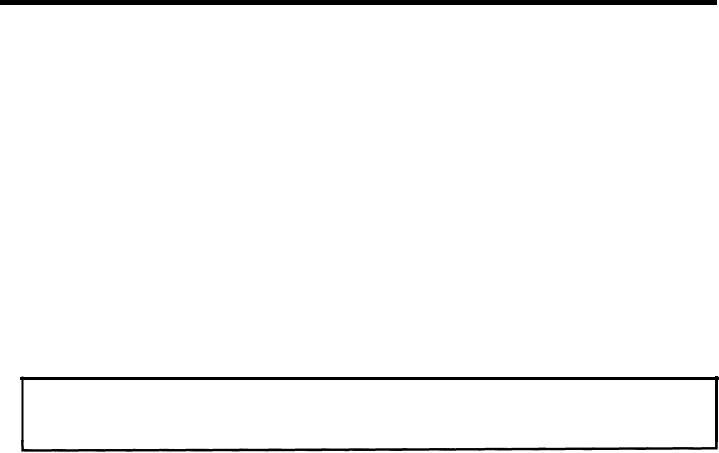
PRECAUTIONS
Reassembly
Make sure that interiors of case and housings are clean. It is important that dirt and other foreign materials be kept out of the transmission during reassembly. Dirt is an abrasive and can damage polished surfaces of bearings and washers. Use certain precautions, as listed below, during reassembly.
1.G A S K E T S — Use new gaskets throughout the transmission as it is being rebuilt. Make sure all gaskets are installed. An omission of any gasket can result in oil leakage or misalignment of
bearing covers. Install PTO and shift bar housing gaskets dry.
2.CAPSCREWS — TO prevent oil leakage and loosening, use Loctite 262 thread sealant on all capscrews . For torque ratings, see TORQUE RECOMMENDATIONS.
3.SHIMS — Apply a light coat of Loctite 510 to both sides of shims before final installation to prevent leakage.
4.ASSEMBLY — Refer to the illustrations provided in
the |
detailed disassembly instructions as a guide |
to |
reassembly. |
5.INITIAL LUBRICATION — Coat all thrust washers, synchronizers, and bearings with transmission lu-
bricant during reassembly to prevent damage during initial start up.
6. END PLAY — Maintain .006 -.010 end play on countershaft and mainshaft assemblies.
7.BEARINGS — Use of a sleeve type driver that contacts the inner race of the bearing is recommended to prevent damage to the rollers and cage.
8.UNIVERSAL JOINT COMPANION FLANGE OR YOKE — Pull the companion flange or yoke into place with the output shaft nut, using 300-350 foot-pounds (407-475 N.m) of torque. Make sure the speedometer drive gear or a replacement spacer has been installed. Failure to properly torque the nut can result in damage to the mainshaft rear bearing.
IMPORTANT: REFER TO THE APPROPRIATE ILLUSTRATED PARTS LIST (SPEClFIED BY MODEL SERIES) TO ENSURE THAT PROPER PARTS ARE USED DURING REASSEMBLY OF THE TRANSMISSION.
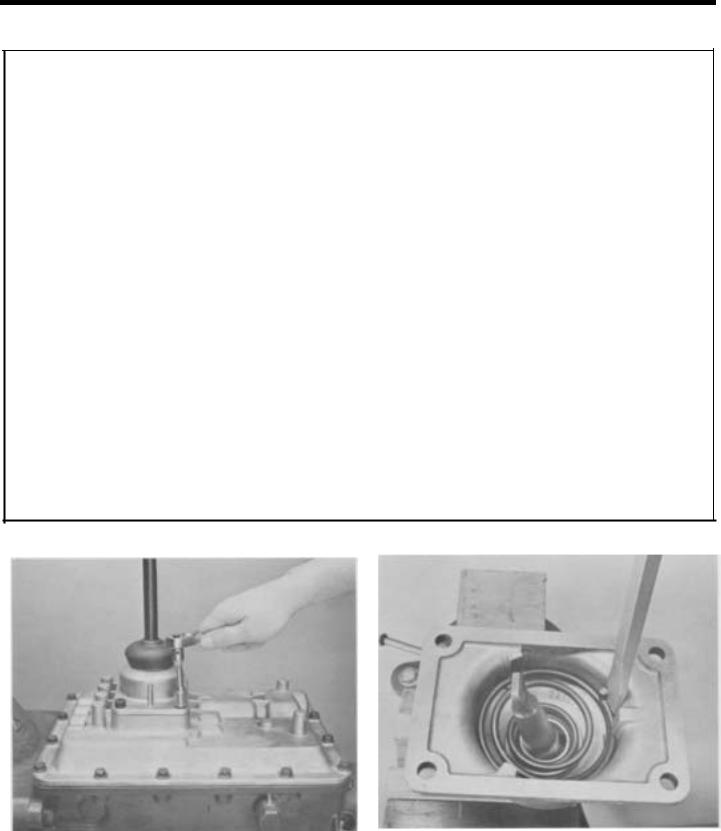
DISASSEMBLY AND REASSEMBLY SHIFTING CONTROLS
GEARSHIFT LEVER HOUSING ASSEMBLY
A. Removal and Disassembly
1.Turn out four capscrews and remove tower assembly and gasket from shift bar housing.
2.Remove shift lever grip and boot from shift lever, secure assembly in vise with bottom of housing
up. Use a large screwdriver to twist between spring and housing, forcing spring from under lugs in housing. Do one coil at a time.
